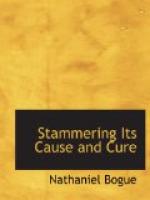(1)—Those resulting from carelessness in learning to speak;
(2)—Those which are of distinct mental form; and
(3)—Those caused by a physical deformity in the organs of
speech themselves.
Regardless of under which of these three heads a speech disorder may come, it is commonly spoken of by the laymen as a “speech impediment” or “a stoppage in speech” notwithstanding the fact that the characteristics of the various disorders are quite dissimilar. In certain of the disorders,
(a)—There is an inability
to release a word; in others,
(b)—A tendency to repeat a syllable
several times before
the following syllable can be uttered; in
others,
(c)—The tendency to substitute an incorrect
sound for the
correct one; while in others,
(d)—The utterance is defective merely
in the imperfect
enunciation of sounds and syllables due to
some organic
defect, or to carelessness in learning to
speak.
While this volume has but little to do with speech disorders other than stammering and stuttering, the characteristics of the more common forms of speech impediment—lisping, cluttering and hesitation, as well as stuttering and stammering—will be discussed in this first chapter, in order that the reader may be able, in a general way at least, to differentiate between the various disorders.
LISPING
This is a very common form of speech disorder and one which manifests itself early in the life of the child. Lisping may be divided into three forms:
(1)—Negligent Lisping
(2)—Neurotic Lisping
(3)—Organic Lisping
Negligent lisping: This is a form of defective enunciation caused in most cases by parental neglect or the carelessness of the child himself in the pronunciation of words during the first few months of talking. This defective pronunciation in Negligent Lisping is caused either by a failure or an inability to observe others who speak correctly. We learn to speak by imitation, and failing to observe the correct method of speaking in others, we naturally fail to speak correctly ourselves. In Negligent Lisping, this inability properly to imitate correct speech processes, results in the substitution of an incorrect sound for the correct one with consequent faulty formation of words.
Organic lisping: This results from an organic or physical defect in the vocal organs, such as hare-lip, feeble lip, malformation of the tongue, defective teeth, overshot or undershot jaw, high palatal arch, cleft palate, defective palate, relaxed palate following an operation for adenoids, obstructed nasal passages or defective hearing.
Neurotic lisping: This is a form of speech marked by short, rapid muscular contractions instead of the smooth and easy action used in producing normal sounds. Neurotic Lisping is often found to be combined with stammering or stuttering, which is quite logical, since it is similar, both as to cause and as to the presence of a mental disturbance. In Neurotic Lisping, the muscular movements are less spasmodic than in cases of stuttering, partaking more of the cramped sticking movement, common in stammering.




